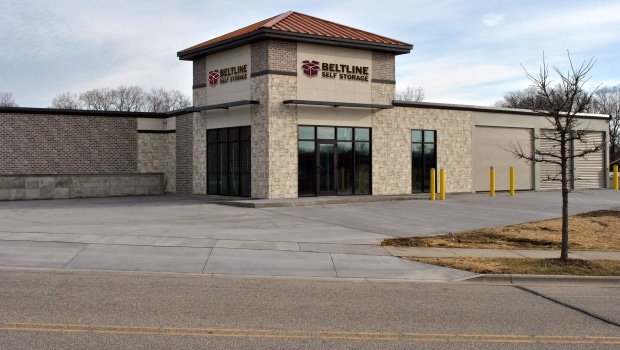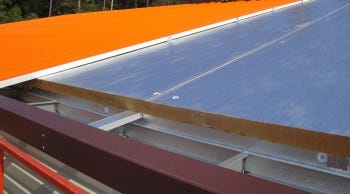From Ho-Hum to Hot Diggity! New Building Materials and Innovative Design in Self-Storage
New building materials and innovative design options can take a self-storage project from ho-hum to sensational. Here’s a look at how some developers are creating more sustainable buildings and improving the appearance of storage facilities nationwide.
May 13, 2015

By Amy Campbell and Zachary Esparza
In many businesses, what looks good sells. This is especially true in the self-storage industry. Facilities with fantastic curb appeal will attract and retain more tenants. However, an attractive property is only as good as the materials used to build it.
Fortunately, there are new building materials and design options on the market that can take a storage project from ho-hum to sensational while also adding energy efficiency to the mix. Here’s a look at how some developers are creating more sustainable buildings and improving the appearance of facilities nationwide.
Aesthetic Enhancement
One of the biggest changes in self-storage design is the use of products that enhance the exterior aesthetic. Although the majority of facilities continue to be built from metal, the surfaces are vastly different from those used even just 10 years ago.
“Not only is there a much broader profile selection, but there are more finishes as well. We’re also seeing architects being more creative with the use of metal panels and accent trim bands,” says Rick Dodge, executive vice president of Paramount Metal Systems, which specializes in self-storage design and construction.
One popular product being incorporated into new self-storage builds is fiber cement, which helps create a smooth exterior. It’s a composite material made of sand, cement and cellulose fibers. The panels made from this substance allow builders to create interesting designs such as horizontal stripes or other shapes and patterns. “Many of our recent projects have included fiber-cement panels with a brick or stone appearance,” says Steve Hajewski, marketing manager for Trachte Building Systems, a manufacturer and supplier of self-storage buildings.

Another building material that’s relatively new to self-storage construction is insulated metal paneling, which comprises a layer of metal skin, a layer of injected  rigid foam and then a second layer of metal skin. “The panels can be used to satisfy fire-rated assembly requirements and can provide the insulation value, waterproof/airproof membrane, and the exterior skin of the building all in one component,” says Eric Reece, project manager for SEA CON LLC, which offers general contracting, construction management and turnkey project development to the self-storage industry. “Insulated metal panels are particularly helpful for construction on sites with tight spaces, zero lot-line sites, in particular as they can be installed from the inside of the building.”
rigid foam and then a second layer of metal skin. “The panels can be used to satisfy fire-rated assembly requirements and can provide the insulation value, waterproof/airproof membrane, and the exterior skin of the building all in one component,” says Eric Reece, project manager for SEA CON LLC, which offers general contracting, construction management and turnkey project development to the self-storage industry. “Insulated metal panels are particularly helpful for construction on sites with tight spaces, zero lot-line sites, in particular as they can be installed from the inside of the building.”
The building method costs slightly more, but the benefits typically make it worth the expense, Reece says. “It allows you to build in areas where you would have to bring in scaffolding.”
In addition to considering the cost of adding these new materials, developers and owners must consider how they’ll affect the structure overall. “When considering architectural finishes, look at the required supporting surface and overall weight,” Hajewski advises. “Communicate with your building supplier regarding any specific studwall spacing, and discuss with them how the building will be insulated. Your choice of architectural finishes can also impact the building foundation requirements.”
For example, an unheated drive-up building with a decorative fiber cement endwall can be built on a floating slab foundation in most areas. If real brick or block were used on the same building, a more costly foundation would be required, Hajewski says.
These are just but a few examples of the materials and products being incorporated into new builds, conversion and even facility renovations. “Nearly any material on the market can be incorporated into a self-storage project,” Hajewski says.
Energy Efficiency
One of the biggest benefits of new building materials is the ability to create a more energy-efficient building. There are now sustainable products and processes for just about every facet of a storage facility, from the roof to unit lighting.
Two years ago, Paramount began experimenting with ridge board to create a better, longer-lasting and more efficient roof system. The company has found the product is easier to install, provides a cleaner appearance, and can even reduce an operator’s utility bill by 50 percent or more when properly installed. “There are now roof-panels systems, just like walls, that are a one-step process for roof and insulation,” says Dodge, who predicts the products such as these will eventually become standard in self-storage construction.
Another area for sustainability and cost-savings is lighting. “Instead of having a switch for a unit if it has a light in it, we will do an automatic on/off switch, more of a motion sensor,” says Brian Yandell, a lead estimator and project manager for SEA CON. “So the initial cost may be more expensive, but the operating cost should be less.”
 Beyond installing environmentally friendly materials, there are other ways developers and owners can incorporate green elements into their design. One is to buy local, which reduces shipping costs and cuts back on fuel. “If you have a builder that has a lot of local experience, you can often find all of your steel studs, sightings and batt insulation. All those could be manufactured within 500 miles, for instance,” Yandell says.
Beyond installing environmentally friendly materials, there are other ways developers and owners can incorporate green elements into their design. One is to buy local, which reduces shipping costs and cuts back on fuel. “If you have a builder that has a lot of local experience, you can often find all of your steel studs, sightings and batt insulation. All those could be manufactured within 500 miles, for instance,” Yandell says.
Recycling your materials during development also contributes to a sustaining a green workplace. “By recycling the majority of scrap materials and separating and segregating them, you’re reducing the impact on the landfill,” Reece says.
While some materials and processes will costs more upfront, developers agree the long-term savings are tangible. “We can now actually show where an investment in the building construction with a higher front-end cost can actually build equity into your project. Energy savings is a value going straight to your bottom line,” Dodge says.
Focus
While it’s easy to pay attention to the beautiful form of a building, owners and developers shouldn’t disregard the structure’s primary function. Overly focusing on the look might spoil its true purpose. “A lot of times, architects like to spec something that looks really cool and neat, but it’s very difficult to build, and it’s very expensive,” Reece says. Rather, all parties involved should focus on functionality as well as a facility’s aesthetics.
“Often times the contractors have a way better feel for materials available locally, what works, and what doesn’t work,” Yandell says. Not only is it crucial to choose the right materials to enhance a facility’s design, but also to zero on where these products will make the biggest impact.
“When adding decorative materials, concentrate on the office or other large walls without doors. Avoid applying specialty finishes to door jambs and headers,” Hajewski says. “These areas are often subject to damage from clients, so it’s best to keep it simple and leave the steel jambs, which are easy to replace if damaged.”
Building materials serve an important role in self-storage design, as they’re the building blocks to an attractive environment. By keeping energy efficiency in mind, the savings can be just as great as the look. Yet a point can be reached when a building is so form-focused that it’s neither feasible nor affordable. To strike a balance, think about the goal of the overall design and what it will take to achieve it.
“There are many cost-effective ways to enhance the appearance of your facility. Your building designer should be more than able to value engineer a broad range of looks,” Dodge says.
Zachary Esparza is a sophomore journalism major at Arizona State University in Phoenix. His emphasis is business journalism with minors in film & media studies and business. He recently interned as a contributing writer to “Bakersfield Life” his city’s lifestyle magazine. After graduation Zachary wants to direct movies someday, while writing about his struggles and successes with owning his own business. To reach him, e-mail [email protected].
You May Also Like





